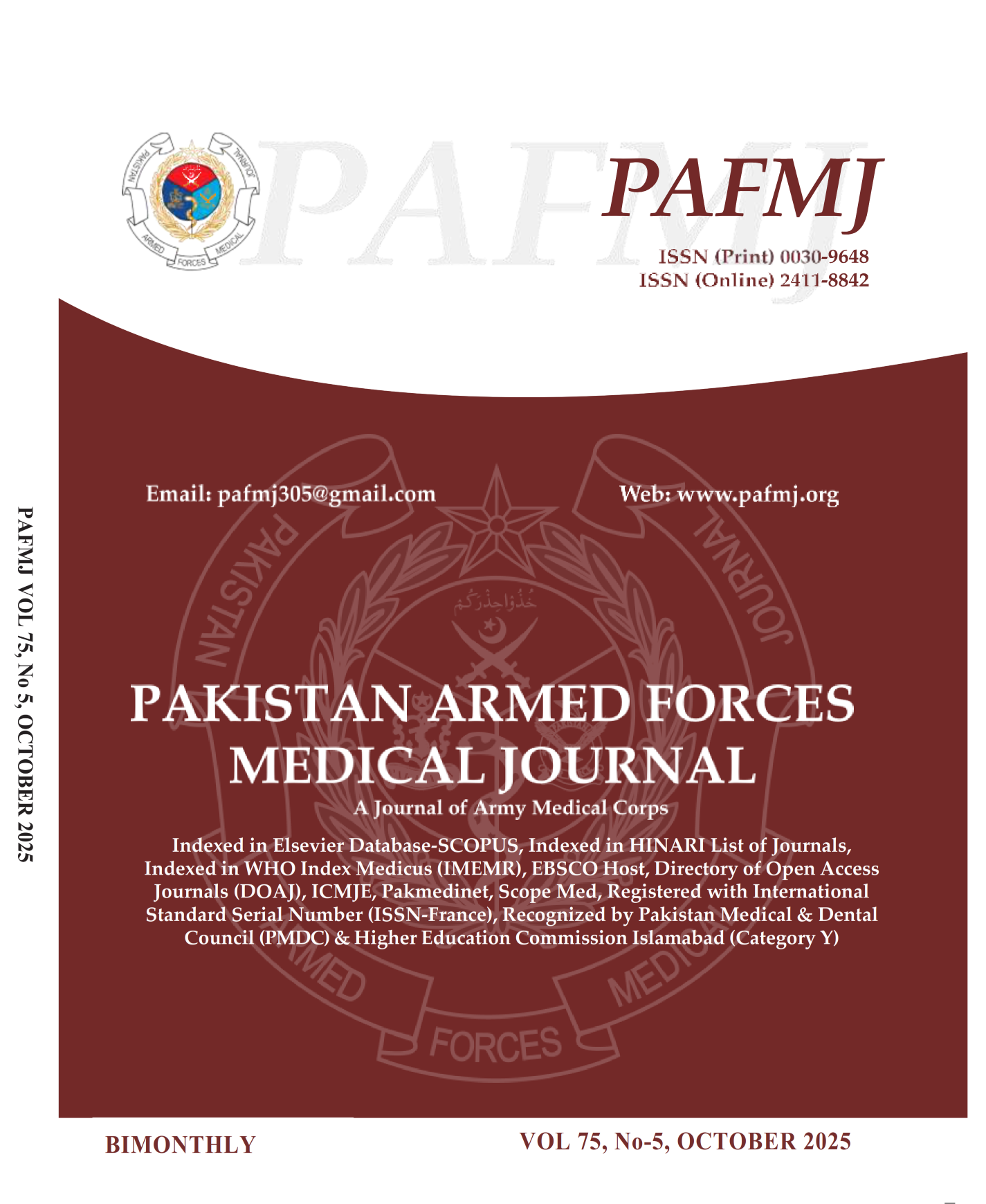Hematological Markers as Predictors of Severity and Outcomes in Firearm Injuries
DOI:
https://doi.org/10.51253/pafmj.v75i5.12430Keywords:
Hematological tests, Injury severity score, Wounds and injuriesAbstract
Objective: To compare the hematological parameters of firearm injury patients on presentation with severity of sustained injuries and to determine the relationship of these hematological parameters with hospital stay duration.
Study Design: Prospective Comparative Study.
Place and Duration of Study: Surgery Department of Secondary Care Hospital Bannu, Pakistan, from Jul 23 to Jun 24.
Methodology: Two hundred and fifty patients presenting to emergency department with firearm injuries were included. All patients underwent complete blood picture analysis on presentation. Patients were followed throughout admission, and blood parameters on arrival were compared with injury severity scores (ISS) and duration of hospital admission.
Results: The median (IQR) age of the study population was 30(25-36) years and 152(60.8%) had sustained severe injuries as per ISS. Median (IQR) hospital admission was 5(2-8) days. Statistically significant association was found between ISS and total leukocyte count, red blood cell count, hemoglobin level, hematocrit, neutrophil count, and lymphocyte count on presentation (p-values <0.05). There was also a statistically significant association between hospital admission duration and total leukocyte count, red blood cell counts, hemoglobin level, hematocrit, neutrophil count, lymphocyte count, and red cell distribution width on presentation (p-values <0.05).
Conclusion: Several hematological parameters of firearm injury patients on presentation are associated with severity of sustained injuries and duration of hospital stay. Neutrophil counts, lymphocyte counts, and red cell distribution width on presentation may serve as important markers for determining severity of injuries and hospital stay in firearm injury patients.
Downloads
References
1. Kodik MS, Akdöner ÖB, Özek ZC. An evaluation of firearm injuries in the emergency department. Cureus 2021; 13(12): e20555. https://doi.org/10.7759/cureus.20555
2. Patel J, Leach-Kemon K, Curry G, Naghavi M, Sridhar D. Firearm injury—a preventable public health issue. Lancet Public Health 2022; 7(11): e976-982.https://doi.org/10.1016/S2468-2667(22)00233-X
3. Vella MA, Warshauer A, Tortorello G, Fernandez-Moure J, Giacolone J, Chen B, et al. Long-term functional, psychological, emotional, and social outcomes in survivors of firearm injuries. JAMA Surg 2020; 155(1): 51-59.
https://doi.org/10.1001/jamasurg.2019.4533
4. Nusretoğlu R, Dönder Y, Biri İ, Gültekin Y. Evaluation of firearm injuries by trauma scoring systems in a secondary health care institution. Ulus Travma Derg 2022; 28(10): 1462.
https://doi.org/10.14744/tjtes.2021.58456
5. Ramsey WA, O'Neil Jr CF, Shatz CD, Lyons NB, Cohen BL, Saberi RA, et al. Nationwide analysis of firearm injury versus other penetrating trauma: it's not all the same caliber. J Surg Res 2024; 294(1): 106-111. https://doi.org/10.1016/j.jss.2023.09.067
6. Öncü MR. Analysis of the factors increasing the mortality in emergency department following firearm injuries. East J Med 2020; 25(1): 55-60. https://doi.org/10.5505/ejm.2020.90267
7. Hu ZD, Lippi G, Montagnana M. Diagnostic and prognostic value of red blood cell distribution width in sepsis: a narrative review. Clin Biochem 2020; 77(1): 1-6.
https://doi.org/10.1016/j.clinbiochem.2020.01.001
8. Wang C, Zhang H, Cao X, Deng R, Ye Y, Fu Z, et al. Red cell distribution width (RDW): a prognostic indicator of severe COVID-19. Ann Transl Med 2020; 8(19): 1230.
https://doi.org/10.21037/atm-20-6090
9. Valenti AC, Vitolo M, Imberti JF, Malavasi VL, Boriani G. Red cell distribution width: a routinely available biomarker with important clinical implications in patients with atrial fibrillation. Curr Pharm Des 2021; 27(37): 3901-3912.
https://doi.org/10.2174/1381612827666210211125847
10. Xing X, Deng Y, Zhu Y, Xu S, Liu J, Zhang C, et al. Red cell distribution width for prognosis in patients with pulmonary embolism: a systematic review and meta‐analysis. Clin Respir J 2020; 14(10): 901-907.
https://doi.org/10.1111/crj.13227
11. Fowler KA, Dahlberg LL, Haileyesus T, Annest JL. Firearm injuries in the United States. Prev Med 2015; 79(1): 5-14.
12. Dehouche N. The injury severity score: an operations perspective. BMC Med Res Methodol 2022; 22(1): 48.
https://doi:10.1186/s12874-022-01528-6
13. Can D, Eryılmaz M. The correlation between hemostatic blood parameters and sepsis in patients with gunshot wounds referred to a training and research hospital. Ulus Travma Derg 2023; 29(5): 605. https://doi.org/10.14744/tjtes.2023.37734
14. Kawai Y, Fukushima H, Asai H, Takano K, Okuda A, Tada Y, et al. Significance of initial hemoglobin levels in severe trauma patients without prehospital fluid administration: a single-center study in Japan. Trauma Surg Acute Care Open 2021; 6(1): e000831. https://doi.org/10.1136/tsaco-2021-000831
15. Figueiredo S, Taconet C, Harrois A, Hamada S, Gauss T, Raux M, et al. How useful are hemoglobin concentration and its variations to predict significant hemorrhage in the early phase of trauma? A multicentric cohort study. Ann Intensive Care 2018; 8(1): 1-10. https://doi.org/10.1186/s13613-018-0420-8
16. Vulliamy P, Kornblith LZ, Kutcher ME, Cohen MJ, Brohi K, Neal MD, et al. Alterations in platelet behavior after major trauma: adaptive or maladaptive?. Platelets 2021; 32(3): 295-304.
https://doi.org/10.1080/09537104.2020.1718633
17. Fields AT, Matthay ZA, Nunez-Garcia B, Matthay EC, Bainton RJ, Callcut RA, et al. Good platelets gone bad: the effects of trauma patient plasma on healthy platelet aggregation. Shock 2021; 55(2): 189-197.
https://doi.org/10.1097/SHK.0000000000001622
18. Janicova A, Relja B. Neutrophil phenotypes and functions in trauma and trauma-related sepsis. Shock 2021; 56(1): 16-29.
https://doi.org/10.1097/SHK.0000000000001695
19. Finlay LD, Morris AC, Deane AM, Wood AJ. Neutrophil kinetics and function after major trauma: A systematic review. World J Crit Care Med 2021; 10(5): 260.
https://doi.org/10.5492/wjccm.v10.i5.260
20. Soulaiman SE, Dopa D, Raad AB, Hasan W, Ibrahim N, Hasan AY, et al. Cohort retrospective study: the neutrophil to lymphocyte ratio as an independent predictor of outcomes at the presentation of the multi-trauma patient. Int J Emerg Med 2020; 13(1): 5. https://doi.org/10.1186/s12245-020-0266-3
21. Manson J, Cole E, De’Ath HD, Vulliamy P, Meier U, Pennington D, et al. Early changes within the lymphocyte population are associated with the development of multiple organ dysfunction syndrome in trauma patients. Crit Care 2016; 20(1): 1-10.
https://doi.org/10.1186/s13054-016-1341-2
22. Lippi G, Bovo C, Buonocore R, Mitaritonno M, Cervellin G. Red blood cell distribution width in patients with limb, chest and head trauma. Arch Med Sci 2017; 13(3): 606-611.
Downloads
Published
Issue
Section
License
Copyright (c) 2025 Ahmed Hassaan Malik, Mumtaz Amir, Muhammad Rehan Saleem, Zulfiqar Ahmed, Arslan Hamid

This work is licensed under a Creative Commons Attribution-NonCommercial 4.0 International License.















